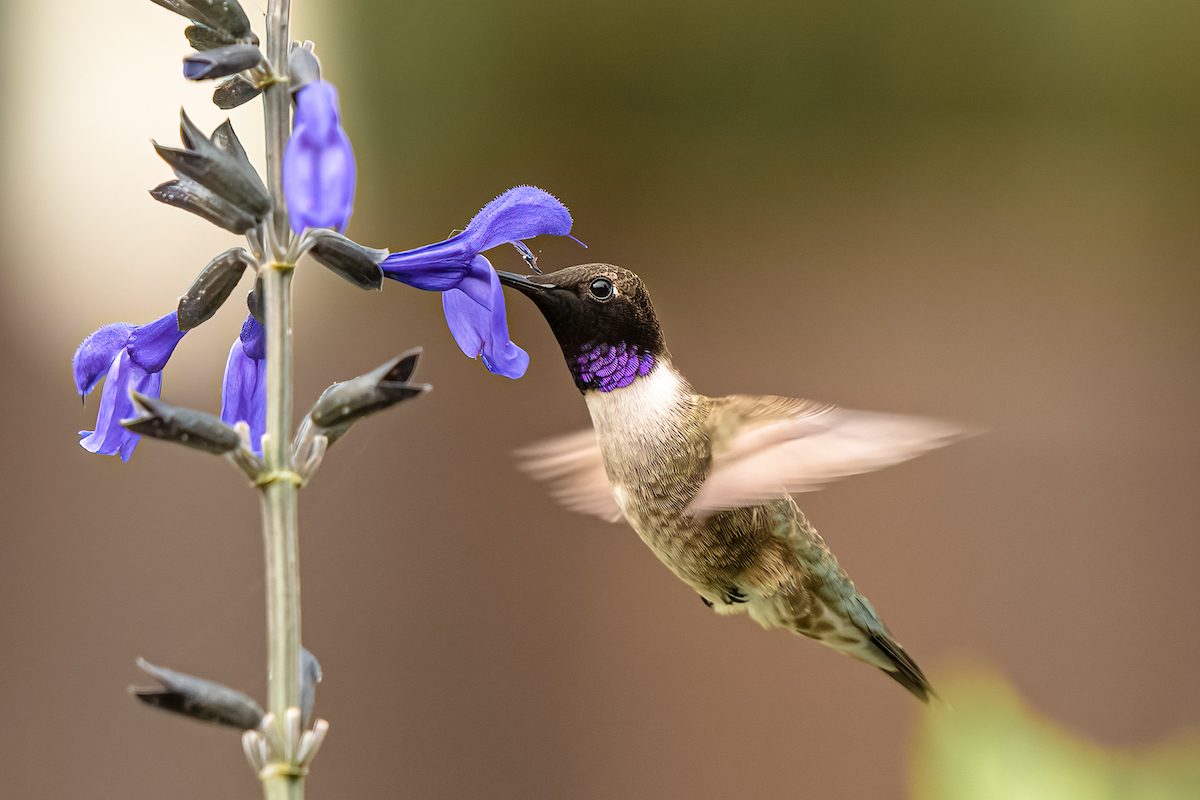Iridescent purple bow ties are the telltale signs of black-chinned hummingbirds. This species is a common backyard visitor in western states.

How to Identify a Black-Chinned Hummingbird

With a range from southern Mexico to British Columbia, black-chinned hummingbirds are commonly seen, yet often overlooked in favor of flashier western species. Let’s learn more about this species, including how to identify the males and females and details about their call, favorite plants and migration habits.
On This Page
What Does a Black-Chinned Hummingbird Look Like?

Black-chinneds are closely related to the ruby-throated hummingbirds of the East, and ranges of the two meet in central Texas.
Jason Fidorra, district wildlife biologist for Washington Department of Fish & Wildlife, says black-chinneds are challenging to identify when compared to Anna’s that might share the same range. “Structure can be more useful than color,” he says. “Note the long and slightly decurved bill of the black-chinned, and the generally thinner body shape and neck compared to similar species such as Anna’s and Costa’s.”
In black-chinneds, Jason says, “Look for a black throat with a thin, deep purple gorget bow tie only visible when the light perfectly reflects to the viewer’s eye.”
When feeding, black-chinned hummingbirds wag and fan their tails. They often find a favorite perch from which they can oversee their territory and will return to that perch repeatedly.
Female Black-Chinned Hummingbirds

Females and immatures of both species are almost identical, with a metallic green back, white undersides and white tips on the outer tail feathers.
A reader wrote in to ask the experts why she never sees the more colorful males. “I seem to only see female black-chinned hummingbirds in my area. Where have all the males gone?” asks Marlys Baldwin of Garden Ridge, Texas.
Birding experts Kenn and Kimberly Kaufman say, “Among black-chinneds and some other hummingbirds, it often seems as if the males have disappeared. This is especially true during and after the nesting season, because all the newly fledged young birds look very much like adult females, outnumbering the more colorful males.
They prefer different habitats too. Males often perch very high, such as on treetop twigs, to scan for females or rival males, while females stay down at garden level and are easier to spot. And since hummingbirds don’t form pair bonds, a male may depart from the area after mating, leaving the female to raise her young.”
Range and Habitat

“Black-chinneds have the second broadest breeding distribution, following the ruby-throated hummingbirds, and occupy a variety of mostly inland habitats including dry scrub, riparian and oak woodlands, and suburban areas where they regularly visit gardens and feeders across their breeding range,” says Jason.
“In the summer they breed primarily in the U.S. from the Rockies and westward, plus western Texas and Oklahoma,” Jason says. “They’re a known and important species to many gardeners, despite their fairly subtle appearance for a hummingbird.”

Black-chinned hummingbirds undergo twice yearly journeys to and from their breeding grounds. They migrate up into the western United States in the summer from western Mexico, where they spend their winters.
Their migration range overlaps their breeding range and includes virtually the entire West from the Rockies to the Cascades and Sierra Nevada. Some birds winter along the Gulf Coast of Texas.
Prior to southward migration, black-chinned hummingbirds often appear at high elevations, seeking nectar flowers that bloom late in summer.
Nesting Habits
Black-chinned hummingbirds might build nests in Cooper’s hawk territories as a strategy to protect them from other predators, according to Tice Supplee, director of bird conservation for Audubon Southwest.
How to Attract a Black-Chinned Hummingbird

Black-chinneds are abundant and adaptable, so it’s easy to encourage them to remain in backyards. Tice says, “People who have a lot of plants and places for hummingbirds to find cover will have them. I encourage people to put in a water feature and grow native plants.” Choose natives for your region, such as penstemons and sages that thrive in much of the West.
Tice also highly recommends a water feature that gently cascades. “When the hummingbird can hover in, it works perfectly,” she says. “Or use a base dish for potted plants and just put one of the drip irrigation emitters in that.”
7 Native Plants to Feed Western Hummingbirds

Black-Chinned Hummingbird Call
Bird sounds courtesy of the Cornell Lab of Ornithology
Their high-pitched warbling song is seldom heard. You may hear chipping calls when they’re chasing intruders. The male’s aerial courtship display produces a trill at the bottom of the dive.
Learn about the many sounds of hummingbirds.
About the Experts
Jason Fidorra works as a district wildlife biologist for Washington Department of Fish & Wildlife. He has worked on bird research and conservation projects across the country and previously sat on the board of the Washington Ornithological Society.
Vashti “Tice” Supplee is Audubon Southwest‘s Director of Bird Conservation. Throughout her career she has worked in research, habitat management, urban wildlife, and game management. At Audubon, she coordinates science-related activities with the National Audubon Society and serves as co-manager of the Arizona Important Bird Areas program.
Sources
- National Audubon Society – black-chinned hummingbird
- The Wildlife Society: Hummingbirds Benefit From Nesting Near Hawks
- Missouri Prairie Foundation: Nectar-rich Natives for Hummingbirds






















